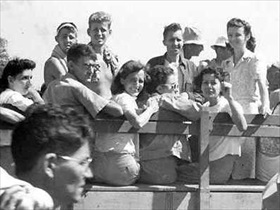MEDICAL AIR EVAC PLANE LOST OVER ALBANIA
Bari, Italy · November 8, 1943
In this date in 1943, 13 U.S. Army flight nurses, 13 young enlisted medics, and 3 flight crew boarded a Douglas C‑53 transport in Sicily for a 90‑minute flight to Bari on the Italian mainland. As a unit of the 807th Medical Air Evacuation Squadron, the team’s assignment was to ferry wounded soldiers to hospitals farther from the front lines. But a winter storm and a crash landing in a remote part of enemy-occupied Albania kicked off a dangerous 800‑mile, monthslong trek to freedom for the only group of flight nurses and medics to have survived so long behind enemy lines in Europe. Bravery, luck, and the heroics of the Albanian underground led to a happy ending, with 23 rescued on January 9, 1944, and the remaining 3 on March 21.
Not all nurses’ stories had a happy ending, though. Of the 54,000 women who served in the U.S. Army Nurse Corps and the 11,000 who served in the Navy Nurse Corps during World War II, a very small percentage died while on active duty (201 Army nurses and 40 Navy nurses). Remarkably, of the almost 80 military nurses captured and interned by the Japanese in the Philippines, all survived their three years of increasingly hellish treatment and months of near starvation. (The nurses lost, on average, 30 percent of their body weight during internment.) Affectionately known as the “Angels of Bataan and Corregidor,” these amazing women, spread between two internment camps, continued to treat the sick and dying around them. In the Los Baños internment camp, a multinational POW and civilian internment camp on an abandoned college campus, 11 Navy nurses functioned as a nursing unit until their rescue by a mixed force of U.S. Army Airborne and Filipino guerrillas on February 23, 1945.
At the Santo Tomas Internment Camp, formerly the campus of the University of Santo Tomas in Manila, 57‑year‑old Capt. Maude C. Davison took command of the Army nurses, maintained a regular schedule of nursing duty, and insisted on her nurses wearing their khaki blouses and skirts while on duty. More than 3,700 civilian men, women, and children, including the nurses, were liberated on February 3, 1945, by a “flying column” of the U.S. First Cavalry Division as it fought its way to Manila. Upon returning stateside, the Army awarded their nurses, among other decorations, the Bronze Star for valor and a Presidential Unit Citation for extraordinary heroism in action. The Navy nurses were likewise awarded Bronze Stars upon their return.
![]()
[amazon_carousel widget_type=”ASINList” width=”600″ height=”200″ title=”Recommended Reading” market_place=”US” shuffle_products=”False” show_border=”False” asin=”1596873167,087013440X,1419710281,0812984846,0813190797,1460973194,1606351540,0962555509,1585443794,006232506X” /]
U.S. Military Nurses at Their Bravest—As Japanese Prisoners of War
 |  |
Above: Freed after three years imprisonment at the Santo Tomas Internment Camp, Army nurses gathered their belongings and boarded trucks on February 11, 1945, a little more than a week after the camp’s liberation, for flights back to the States. The former captives were given new Army uniforms to replace their worn-out clothes and were the recipients of lipsticks, shoes, and civilian clothing donated by other nurses. Santo Tomas, in addition to its civilian internees (mostly Americans, British, Canadians, and Australians of both sexes), was the initial internment camp for Navy nurses (11), Army nurses (66), and one nurse-anesthetist after the Japanese captured Manila (January 1942) and the island fortress of Corregidor (May 1942). To reduce overcrowding at Santo Tomas, in May 1943 the Navy nurses left to help establish a new camp at Los Baños, some 40 miles south of Manila, with an initial set of 800 male internees.
 |  |
Left: A truckload of some of the 2,147 Allied civilian and military internees from the Los Baños Internment Camp after their February 23, 1945, rescue, which occurred during the height of the Battle of Manila. Gen. Douglas MacArthur, Supreme Commander for the Southwest Pacific Area, had grown ever more alarmed about the plight of the thousands of Los Baños prisoners who, with deliverance so near, might be killed by retreating Japanese soldiers. (A nurse internee learned later that the Japanese had planned to execute everyone in the camp the very morning of their rescue.) Lasting an hour or at most two, the Los Baños Raid by a company of U.S. paratroopers, 300 troops in amtracs (amphibious tractors), and 800 Filipino guerrillas is considered as one of the most successful rescue operations in the history of World War II.
![]()
Right: Chief Nurse Laura Mae Cobb (1892–1981) and ten other Japanese-internee Navy nurses speak to Vice Admiral Thomas Kinkaid after their rescue from Los Baños. The nurses were known as “the sacred eleven” by camp inmates. After returning to the U.S., Cobb was promoted to Lieutenant Commander and awarded the Bronze Star, a Gold Star in lieu of a second Bronze Star, the Defense of Philippines Ribbon, a Distinguished Army Unit Citation, and the Asiatic-Pacific Theater Ribbon with two Battle Stars.
11th Airborne Los Baños Rescue, February 23, 1945. Includes Interviews with Rescuers
![]()
 History buffs, there is good news! The Daily Chronicles of World War II is now available as an ebook for $4.99 on Amazon.com. The ebook contains a year’s worth of dated entries from this website. Featuring inventive navigation aids, the ebook enables readers to instantly move forward or backward by month and date to different dated entries. Simple and elegant! Click here to purchase the ebook.
History buffs, there is good news! The Daily Chronicles of World War II is now available as an ebook for $4.99 on Amazon.com. The ebook contains a year’s worth of dated entries from this website. Featuring inventive navigation aids, the ebook enables readers to instantly move forward or backward by month and date to different dated entries. Simple and elegant! Click here to purchase the ebook.












